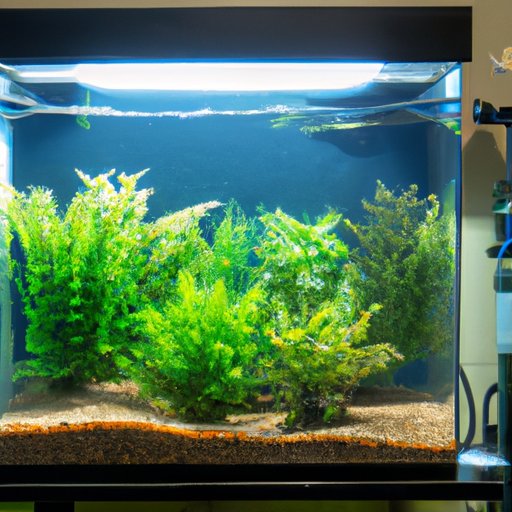
Introduction
A fish tank is a beautiful addition to any home, providing the perfect showcase for colorful and fascinating aquatic life. As a fish owner, it is your responsibility to maintain a healthy environment for your fish, and one essential aspect of that is monitoring and maintaining nitrates. High levels of nitrates in your fish tank can be harmful to your fish and potentially fatal in extreme cases. In this article, we will explore how to lower nitrates in your fish tank and keep your aquatic pets happy and healthy.
Test the Water
The first step in maintaining healthy nitrates in your fish tank is to test the water regularly. You can purchase an aquarium test kit at your local pet store or online. Make sure to follow the instructions carefully when using the test kit and take note of the readings. Ideally, you want the nitrate levels in your fish tank to be between 5 and 20 ppm (parts per million). If the levels are higher than 20 ppm, it’s time to take some action.
Some possible actions to take if nitrates are too high include performing water changes, adding live plants, increasing aeration and filtration, reducing feed quantity, and using nitrate-reducing supplements.
Water Changes
One of the most effective ways to lower nitrates in your fish tank is through regular water changes. The amount of water you change and how often you change it will depend on the size of your fish tank, the number of fish, and the level of nitrate buildup. As a general rule of thumb, aim to change 20% of your tank’s water every two weeks. If your nitrate levels are particularly high, you may need to perform more frequent or larger water changes.
To perform a water change, you will need a siphon and a bucket. Start by shutting off all electrical equipment, such as filters and heaters. Place one end of the siphon in the tank and the other end in the bucket. Suck on the end of the siphon until the water starts flowing, and then carefully move the siphon around the tank to remove debris and waste. Once the desired amount of water has been removed, turn the faucet to fill the bucket with fresh water and use a water conditioner to remove any chlorine or other impurities. Then, slowly pour the new water back into the tank.
Water changes have additional benefits besides reducing nitrates. They also help to remove excess waste, replenish minerals and trace elements, and maintain a stable pH balance in your fish tank.
Use Live Plants
Live plants are not only a beautiful addition to any fish tank, but they can also help to reduce nitrates by absorbing them through their leaves. Some of the best plants for removing nitrates include Anacharis, Hornwort, and Java Moss. Before adding live plants to your fish tank, make sure to do your research and choose ones that are compatible with your fish and tank set up.
Live plants require care and maintenance, including providing them with proper lighting, carbon dioxide, and nutrients. Make sure to follow specific care instructions for each plant, and prune them regularly to prevent overgrowth.
Increase Aeration and Filtration
Good aeration and filtration are essential for maintaining healthy nitrates in your fish tank. Good filtration will help to remove waste and excess food particles that can contribute to nitrate buildup. Make sure to properly clean and maintain your filter regularly.
In addition to using a filter, you can also increase aeration in your fish tank by using a bubbler or air stone. These devices help to increase oxygen levels in the water, which can lead to better bacteria colonies that break down waste and prevent nitrate buildup.
Reduce Feed Quantity
Overfeeding is one of the most common causes of high nitrate levels in fish tanks. When fish are overfed, food particles break down and contribute to the tank’s waste buildup. Identify the correct amount of food your fish need and feed them small, frequent meals instead of one large meal. In general, fish should only be fed as much as they can consume in two minutes.
Use Nitrate-Reducing Supplements
Nitrate-reducing supplements are an easy and effective way to lower nitrates in your fish tank. These supplements contain beneficial bacteria that help to break down nitrate into less harmful compounds. Make sure to choose the right type of supplement for your tank and follow the instructions carefully. Nitrate-reducing supplements work best when used in conjunction with other strategies, such as regular water changes and good filtration.
Perform Regular Tank Maintenance
Regular maintenance is key to maintaining healthy nitrates in your fish tank. Make sure to clean your fish tank once a week to remove any debris and waste. To properly clean your fish tank, use an algae scraper to clean the sides of the tank, a gravel vacuum to clean the substrate, and a clean cloth to wipe down any decorations or surfaces. Make sure to also check the temperature and pH levels of the water regularly.
Additional Tips and Conclusion
By following the strategies outlined in this article, you can maintain healthy nitrates in your fish tank and provide a healthy and happy home for your fish. Remember to test your water regularly, perform regular water changes, use live plants and good filtration, reduce feed quantity, use nitrate-reducing supplements, and perform regular tank maintenance. Additional tips include avoiding overstocking the tank, avoiding overuse of medications and treatments, and avoiding drastic changes in water conditions.
Remember, maintaining healthy nitrates in your fish tank is essential to the health and longevity of your aquatic pets. By taking these steps, you can ensure that your fish stay happy, healthy, and vibrant for years to come.




